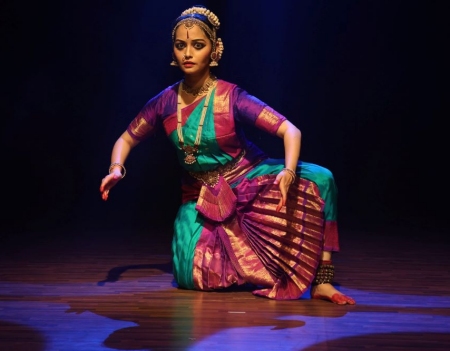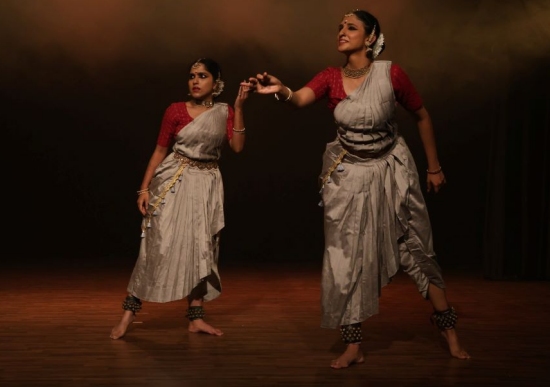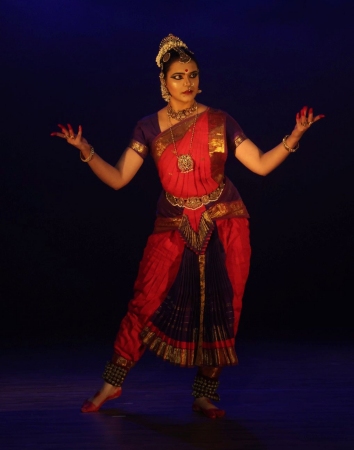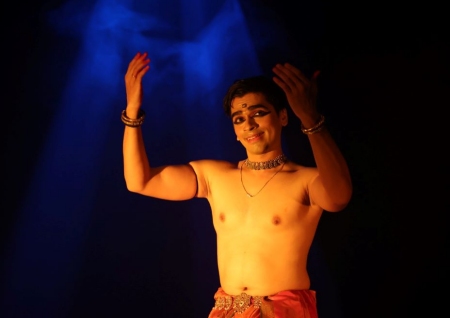
|   |

|   |
Youth in Dance 2024 - Shashank Kiron Nair e-mail: shashank.k.nair@gmail.com Photos: Srivatsa Shandilya June 18, 2024 Youth in Dance 2024 was hosted by the Padmalaya Foundation, run by Guru Padma Murali and her daughter Janani Murali, at Medai the Stage in Bangalore on June 9, 2024. The event featured performances by three upcoming dancers alongside students from the foundation. Each year, the festival selects a theme, encouraging performers to stage thoughtful presentations. This year's theme was Sthalam - the Space. The question of what transforms a regular space into a Sthalam, raised by one of the performers, was thought provoking. It sparked a deeper appreciation for the theme. Sthalam encompasses both tangible elements and intangible essences, such as history, lore, and the people that inhabit a space. Each of these aspects adds layers to what we ultimately perceive as a place or Sthalam. It was interesting to witness how each of the performers understood the idea of Sthalam and how it was emulated in their art.  Divya Bhat The evening began with a performance by Divya Bhat titled 'Echoes of Kashi,' based on the ancient cultural center known as the city of lights. The piece was a unique take on the idea of Sthalam. From what one in the audience might glean, the production aimed to abstract the city's extensive history into a narrative explored through the perspective of Nandi. Directed and scripted by Sharat Prabhath, the work was choreographed and skilfully rendered by Divya Bhat. Her captivating stage presence, coupled with Anga Shudhi and precision in nritta, made Divya's performance a visual treat. She commenced with a lively Pushpanjali, which eventually introduced the audience to the Sthalam of Kashi and the narrator, Nandi. The performance continued with another predominantly nritta based segment highlighting various facets of Nandi, followed by a depiction of Shiva and Parvati's dance in Sundarvan, seen through Nandi's eyes. Divya then visualized the Ganga Aarti at Kashi. The stunning and innovative lighting design stole the thunder briefly. The narrative transitioned from mythology to history, portraying the numerous attacks and plundering of Kashi through evocative nritta and abhinaya that heavily relied on vachika (verbal expression) in poetic Kannada. The piece depicted the trepidation of attack and the awe-inspiring irony of devotees coming to the rescue of the lord. Aptly weaving in the Kalabhairavashtakam, the choreography portrayed the fierce Bhairava thwarting Yama, who was wreaking havoc in his land, before turning to stone. Nandi laments the absence of his Lord in Kashi but then comes to realize that Shiva is eternally present in Kashi as its Vishwanath. Divya ended with a Thillana, tactfully highlighting Nandi's tie with the mridangam. The sahitya for the Thillana was the popular shlokam "Ganga taranga ramaniya jata kalapam ... Varanasi purapathim bhaja Vishwanatham," possibly the most fitting conclusion to the piece. Divya's performance, predominantly through nritta and vachika abhinaya, well imbued the air with the essence of poignant devotion. The presentation was supported by: Nattuvangam and narration: Vidyashree Radhakrishna, vocals and music composition: Sivasri Skanda, mridangam and rhythmic inputs: Shyam, violin: Pradesh Achar, flute: Bharath Atreyas.  Padmalaya ensemble The next segment focused on yet another Sthalam where Shiva reigned supreme - Ujjain. Presented by the students of Padmalaya Foundation, the work was a maiden choreography by Poshini Zunjarwad and Anindita Ashok, who were accompanied by Sahana Kaushik and Sahasra Jayanth in performance. The work seemed to approach the concept of Sthalam in terms of its ancient historical and mythological roots. The origin story of Ujjain involves a dispute among Brahma, the creator, and Vishnu, the preserver, over who was supreme. To resolve this, Shiva appeared as an infinite pillar of light, the Jyothirlinga, challenging both deities to find its beginning or end. Neither could do so, acknowledging Shiva's supremacy. The presentation opened with this story and then went on to highlight the significance of Ujjain as a center of learning and culture. According to legend, envious scholars and courtiers, in an attempt to embarrass the King of Ujjain, convinced him to marry the princess to Kalidasa, who was then a simple-minded, uneducated woodcutter. The princess, known for her intelligence and learning, scorned Kalidasa and left him. Deeply hurt and determined to change his fate, Kalidasa prayed fervently to the goddess Kali, seeking wisdom and knowledge. Moved by his sincere devotion, the goddess Kali appeared before him and granted his wish, transforming him into a man of extraordinary intellect and poetic genius. Kalidasa went on to become a great literary figure and authored classics like Shakuntala and Meghaduta. This tale was brought to life on stage by the dancers. The performance was commendable for its thoughtfulness and effort, especially considering it was a first-time choreography. It showcased the vast potential of these promising dancers. The performances by Divya and Padmalaya Foundation had Keerthi Kumar on the lights.  Kavya Kasinathan The next Sthalam on the list was Madurai, down south. The work, aptly titled 'Madhuram,' was choreographed and presented by Kavya Kasinathan with inputs and mentoring from her Guru Mithun Shyam. The piece was an excerpt from an extensive production that approached the idea of Sthalam in a manner distinct from every other piece staged that evening. Kavya, in lieu of the regular linear chronological approach, escorted the audience on a journey of Madurai through a unique sensorial take, dwelling on how the city caters to each of the five senses. Kavya took to the stage in the role of Kannagi from the epic tale synonymous with Madurai, Silapadhikaram, representing the idea of destruction and rebirth of the city. Dwelling on the tactile experience of Madurai's rejuvenated landscape, she described the natural beauty of the city. The second sequence focused on the sense of smell, narrating the story of the repeated discovery of the Shivalingam following the alluring aroma of Chandanam (sandalwood paste). Next was the sense of hearing, recounting the tales of Meenakshi and Shiva's compassion, not just towards their devotees but every being, including a litter of orphaned piglets. Madurai is known for its opulent cuisine. Kavya deftly displayed the sense of taste using the popular folk tale of Gundodaran. The vocal score in this sequence by Mahesh Swami, which infused sounds of smacking lips, burps, crunching, and munching, drove the scene to success. Kavya concluded by visualizing the grandeur of the Chithirai Thiruvizha of Madurai addressing the sense of sight. Typical of an artistic mind on overdrive, Kavya's performance was packed from start to end with relevant anecdotes, striving to showcase as much as possible. The little nritta that Kavya rendered was tasteful and left the audience wanting more. Kavya was supported with lighting by Nithin Shakthi.  Shobhit Ramesh The final presentation for the evening was by Shobhit Ramesh, who staged 'Udupi: Devotional and Timeless.' Shobhit's presentation approached Sthalam from yet another perspective. It seemed to place Udupi's deity, Krishna, as the pivot, letting the choreography deliberate upon him and his facets as the central theme. Essentially an elaborate varnam, the piece was the brainchild of Parshwanath Upadhye, with resource inputs from Pradesh Achar and music composed by the vocalist Raghuram Rajagopalan. The presentation was accompanied by Aditya PV on nattuvangam, Harsha Samaga on the mridangam, Suma Rani on the sitar and Parshwanath Upadhye on the lights. The piece commenced with the popular Purandaradasa Ugabhoga - "Aaneyu karedare, Adimoola bandanthe...". Following the traditional framework, the varnam was well articulated with ingenious nritta executed to perfection and well-disposed sancharis rendered with a charming balance of lokadharmi and natyadharmi. Shobhit's performance was a strong reminder of the brilliance of his acharya, Parshwanath Upadhye. The story of Udupi goes: one day in Dwarka, Devaki expressed her desire to see Lord Krishna as a child. Krishna immediately agreed, took the form of Balakrishna, and played with her. Witnessing this, his wife Rukmini commissioned an idol of this form made from shaligram stone. Years later in the 13th century, a ship from Dwarka was caught in a storm and guided ashore by Sage Anandatirtha later known as Madhvacharya. In gratitude, the captain offered him anything from the ship. The saint chose a rocky ballast, which, to his surprise, encased the shaligram idol of Balakrishna in Gopi Chandan. Madhvacharya bathed the idol and installed it, thus creating the famous Udupi Krishna Temple. The often performed, iconic story of Kanaka Dasa and the Kanakana Kindi was smartly left to the imagination of the audience by the choreographer. Youth in Dance 2024 showcased diverse interpretations of the concept of Sthalam, allowing each performer to highlight their unique perspectives and creativity. The thoughtful presentations underscored the richness of our cultural heritage and the intricate connection between history, mythology, and artistic expression. The event was a commendable undertaking by the Padmalaya Foundation, leaving the audience with a deeper appreciation for the spaces that shape our cultural narratives and vice versa.  Shashank Kiron Nair is a Bharatanatyam dancer, Carnatic vocalist and student of Architecture at BMS College of Architecture. He is a recipient of the Kalashree Prashasti 2017-18 and Karnataka Sangeetha Nritya Academy scholarship 2021-22. |